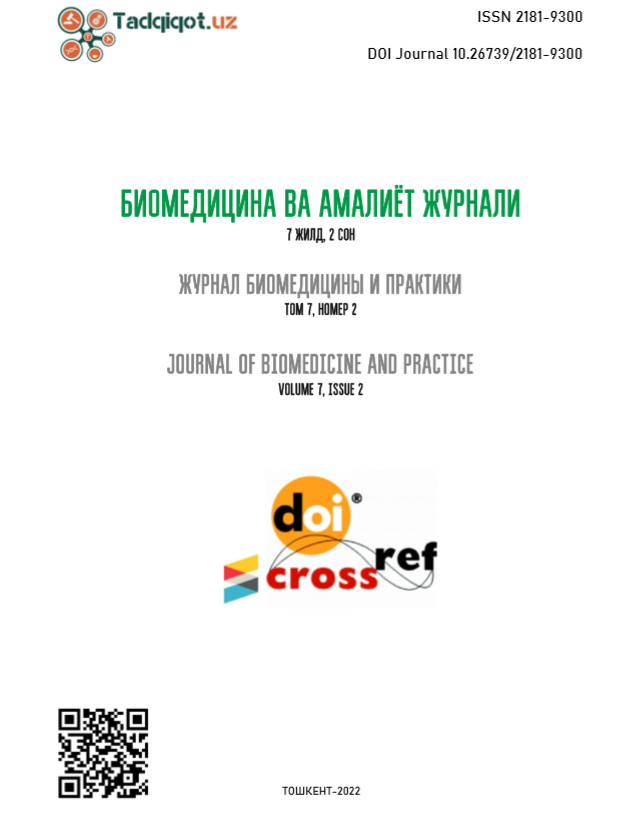MONITORING NEPHROPATHIES IN TYPE II DIABETES MELLITUS USING LABORATORY STUDIES
Keywords:
diabetic nephropathy, laboratory analysis, type 2 diabetes mellitusAbstract
Objective: To assess the severity of nephropathy in diabetes mellitus according to laboratory parameters.
Methods: The study was carried out on the basis of the Samarkand Regional General Hospital, Department of Nephrology. To achieve this goal, a retrospective study was carried out from a patient card. The number of patients with nephropathy in diabetes mellitus is 20. Of these, 12 (60%) are men, 8 (40%) are women. The average age is 59.5.
The results obtained: The main group included 20 patients with various courses of nephropathy. During clinical and laboratory examination, it turned out that in the general analysis of blood, the main changes are associated with red blood cells, which is manifested by a decrease in their number. The erythrocyte sedimentation rate (ESR) in all patients is sharply increased. When studying the biochemical parameters of the serum of patients, it was found that the residual nitrogen products are sharply increased, in all patients the level of cholesterol is moderately increased and the total protein is lowered.
A general analysis of urine revealed protein in high concentrations, leukocytes and erythrocytes in insignificant amounts.
Conclusions. Laboratory changes indicate that in most patients of the main group, nephropathy was complicated by chronic renal failure in the thereminal stage.
References
Г.Б. Кувандиков, З.Э.Кудратова, Н.А. Юсупова, Бердиярова Ш.Ш. Проблемы достоверность результатов лабораторной диагностики инфекций, передаваемых половым путем// EVROPEAN RESEARCH: INNOVATION IN SCIENC, EDUCATION AND TECHNOLOGY. 2020. C. 79-82.
Душанова Г.А., Набиева Ф.С., Садинова М.Ж., Нурматова Д.М. Анализ взаимосвязей параметров иммунного гомеостаза с сосотоянием системы ПОЛ-АОС// Вестник науки и образования. № (105) часть 2- 2021, C.63-69
Спиридонова Е.С. Медико-социальная характеристика больных с урологической патологией // Сестринское дело и высшее сестринское образование: материалы-практической конференции. Уфа: Вагант, Вып. 3.2010. С. 60-62.
Ибрагимова, Н.С. Ибрагимова. Роль гомоцистеина в патогенезе синдрома поликичтозных яичников у женщин Б.Ф. //international scientific review. Вып. 3, -2020, C.3
Юсупова Н.А.Негмаджонов Б.Б.Бердиярова Ш.Ш. Роль сбалансированной микрофлоры в поддержании гомеостаза влагалища// Достежения науки и образования - № 14. 2020, С. 74-77.
Шарафутдинов М.А. Динамика и прогноз заболеваемости взрослого населения Республики Башкортостан болезнями мочеполовой системы // Медицинский вестник Башкортостана.
№ 6. 2010 С. 11—1
Garber A.J., Abrahamson M.J., Barzilay J.I. et al. AACE Comprehensive Diabetes Management Algorithm 2013// J. Endocr. Pract, -№ 2. -2013 P. 327-336.
Coffey, J.T., Brandle, M., Zhou, H. et al, Valuing health-related quality of life in diabetes// Diabetes Care, 2017. P. 2238–2243.
Jichlinski P.Urology // Rev Med Suisse. 2014. V. 10 (412-413). P. 127-9.
Rizaev J.A. Influence of fluoride affected drinking water to occurrence of dental diseases among the population // Eurasian Journal of BioMedicine, Japan, Vol. 4, Issue 5, P.1-5 19.
Rizaev J.A., Khazratov A.I. Carcinogenic effect of 1,2 - dimethylhydrazine on organism as a whole // Problems of biology and medicine, 2020. № 1. Vol. 116. С. 269. 20.
Rizaev J.A., Khazratov A.I., Lisnichuk N.E., Olimjonov K.J., Reimnazarova G.J. Pathomorphological changes in the oral mucosa in patients with colon cancer// European Journal of Molecular & Clinical Medicine, vol.7, Issue 7, P.666-672. 21.
4.Pomerantsev, V.P. Diagnosis, treatment and quality of life // Clinical medicine. - No.9- 2018, P. 3.
Т.С. Ospanova I.V. Zaozerskaya Changes in the quality of life of patients at different stages of chronic kidney disease in diabetes mellitus. Scientific bulletins. Series Medicine. Pharmacy. 2013. No. 25 (168). Issue 24. P. - 60- 65.

